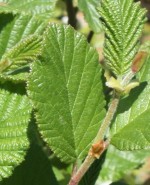 Speckled alder is a deciduous native shrub or tree growing in wet soils around ponds, streams, and ditches from Labrador to Alaska and British Columbia, south to Virginia, Iowa, New Mexico, and California. It is a member of the birch family, Betulaceae, that also includes hazels, alders and hornbeams. The plant usually grows as a thicket but can be grown as a multi-stemmed tree. The grayish to reddish brown trunks are smooth and the brown stems are speckled with white lenticels that give it its common name, speckled alder. The branches are twiggy and carry quilted leaves two to four inches long. The dull green leaves are leathery with red hairs on their underside and are not showy in the fall. Male and female flowers appear in separate catkins on the same tree in early spring before the leaves. The male catkins are purplish brown, to 3 ½” long and pendent. The female catkins are green, to ½ inch, rounded, and give way to one inch long cone-like fruits bearing winged seeds that provide food for birds into winter. The texture of the plants is coarse for most gardens but they are useful for wet areas especially in casual plantings. The genus name Alnus is the classical Latin name for the plant. The specific epithet, incana, is the Latin word for hoary/quite gray and refers to the color of the bark. The epithet rugosa is the Latin word for wrinkled and refers to the texture of the leaf.
Speckled alder is a deciduous native shrub or tree growing in wet soils around ponds, streams, and ditches from Labrador to Alaska and British Columbia, south to Virginia, Iowa, New Mexico, and California. It is a member of the birch family, Betulaceae, that also includes hazels, alders and hornbeams. The plant usually grows as a thicket but can be grown as a multi-stemmed tree. The grayish to reddish brown trunks are smooth and the brown stems are speckled with white lenticels that give it its common name, speckled alder. The branches are twiggy and carry quilted leaves two to four inches long. The dull green leaves are leathery with red hairs on their underside and are not showy in the fall. Male and female flowers appear in separate catkins on the same tree in early spring before the leaves. The male catkins are purplish brown, to 3 ½” long and pendent. The female catkins are green, to ½ inch, rounded, and give way to one inch long cone-like fruits bearing winged seeds that provide food for birds into winter. The texture of the plants is coarse for most gardens but they are useful for wet areas especially in casual plantings. The genus name Alnus is the classical Latin name for the plant. The specific epithet, incana, is the Latin word for hoary/quite gray and refers to the color of the bark. The epithet rugosa is the Latin word for wrinkled and refers to the texture of the leaf.
Type: Shrub or small to medium tree
Outstanding Feature: Leaves; tolerance of wet soil
Form: Rounded crown
Growth Rate: Rapid
Bloom: Purplish brown, pendent male catkins up to 3.5 inches long and green rounded ½ inch female catkins on the same tree in early spring
Size: 10-25’ H x 10-25’ W (up to 30’ tall as tree)
Light: Full sun to light shade
Soil: Average, wet to consistently moist
Hardiness: Zones 2-7
Care: Trim to form trees if desired.
Pests and Diseases: Generally healthy but susceptible to canker, powdery mildew, leaf curl, aphids, leaf miners, tent caterpillars, lace bugs, and flea beetles.
Propagation: Seed, division, layering